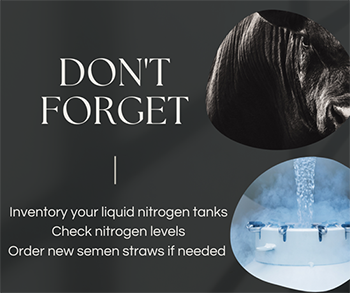
Artificial Insemination: Semen Storage & Handling

Introducing artificial insemination (AI) into your operation can seem like a daunting task but understanding basic principles will allow you to easily begin incorporating the technique and reaping the economic benefits. Cows bred via AI produce genetically superior calves based on producer preference and selection. Moreover, cows bred to AI calve earlier leading to an increased calving interval in dams and increased weaning weights.
This article focuses on principles of semen storage and handling in artificial insemination and provides research-based management practices to increase success.
Managing Liquid Nitrogen Tanks
Before you can order semen for AI, you must have a place to store it. Cryopreserved semen is kept within liquid nitrogen tanks that are available in different sizes to accommodate your operation. The life expectancy of these tanks is between 10-12 years; thus, when purchasing it is best to consider your long-term goals and invest in a tank that will last. Tanks and semen straws can be purchased from semen companies, but it is important to establish a working relationship with your regional sales representative as they will help with tank maintenance and liquid nitrogen refills. Below are key elements to consider when purchasing and managing a liquid nitrogen tank.
- Size & Storage
Liquid nitrogen tanks need to be stored in a well-lit and ventilated area on an elevated surface, such as a wood pallet. Direct contact with concrete or flooring will corrode the outer aluminum shell of the tank. Thus, establishing where the tank will be stored can determine the size of the tank. Moreover, a key component to consider is the diameter of the neck opening. The larger the opening the easier it is to pull out semen straws, but these tanks need to be refilled more often as more liquid nitrogen is lost every time the tank is opened. Tanks with narrow openings are great for those experienced with semen handling and have increased time between refills. - Liquid Nitrogen & Tank Maintenance
Liquid nitrogen levels within the tank need to be monitored and refilled as needed. Typically, your semen representative will set up dates to provide refills at your operation and these should be discussed upon purchase. To check a tank, place either a plastic or wooden measuring stick (do not use metal) to the bottom of the tank, allow it to cool, withdraw the stick, and read the level of frost. Regularly checking and refilling tanks will prevent damage to semen. The temperature within the bottom of the liquid nitrogen tank is -320°F. Damage to semen integrity begins at -104°F; thus, it is extremely important to make sure that appropriate nitrogen levels are maintained. If the exterior of the tank needs cleaned, it is best to use a damp rag to wipe away dirt or dust. Do not hose off a liquid nitrogen tank or use excessive amounts of water, this can compromise the internal temperatures. - Inventory Tank
When thawing semen, you want do not want to spend excessive amounts of time trying to find a specific straw within the tank. Thus, as semen straws are added or removed to the tank their location should be inventoried. This is typically done by assigning bulls to specific cannisters, tracking the number of canes each bull has within the cannister, and updating throughout the breeding season.
Thawing a Semen Straw
Following a strict process when thawing cryopreserved semen is crucial to maintain semen integrity and increase success when using artificial insemination.
- Place all artificial insemination rods in a gun warmer or close to your body. This will warm the metal to prevent cold shocking semen when loading the gun.
- Utilize an electric thaw bath with a lid at a temperature of 94-96°F. Thaw baths at the wrong temperature will result in dead semen and poor conception rates. Always check the thaw bath temperature BEFORE removing a straw from the liquid nitrogen tank.
- Check tank inventory and identify your working cannister. Move the cannister from the locked position to the center of the tank and identify the cane you need.
- Pull the cannister into the neck of the liquid nitrogen tank, use your fingers to pull the cane out of the cannister, drop the cannister below the frost line. Remove one straw from the cane and drop the cane back into the cannister. *
- This process should be under 8 seconds to prevent damage to semen quality.
- Leave the semen straw in the thaw bath for a minimum of 45 seconds with the lid closed.
*It is recommended to wear light gloves when handling metal that has been in liquid nitrogen as it can cause burns on the skin. However, gloves can limit dexterity to complete the task in a timely manner. The choice to wear gloves is up to the individual.
Loading an Artificial Insemination Rod
Once the semen straw has been in the thaw bath for 45 seconds, must transfer it to the artificial insemination rod. The potential for cold-shock, light damage, water damage during this step is high. It is important to follow the below guidelines to increase pregnancy success.
- Remove the semen straw and use a paper towel to remove excess water from the outside of the straw.
- Keep the semen straw in the paper towel to prevent damage from light.
- Pull back the plunger of your warmed AI rod approximately 4 inches.
- With the straw still in a paper towel, load the straw, cotton plug first, into the AI rod.
- Use scissors or straw cutters to clip the end of the semen straw at a 90° angle with the paper towel still around the end of the straw and rod.
- Place sheath over the semen straw and AI rod until it is secured in place at the end of the AI rod. Typically, you can hear the straw “click” into place once the sheath is secured.
- Place the AI rod back into the gun warmer or close to your body to prevent cold shock.
- Semen must be deposited within the female tract within 15 minutes of thawing for optimal success.
Tips For Technique Success
The best way to get started learning the technique is through attending an artificial insemination school where you can get hands-on practice and help for your first time. However, once the initial learning is accomplished, the only way to get proficient in AI is to practice. Below we outline general steps of artificial insemination with helpful tips to increase pregnancy success.
- Use lube and a palpation sleeve on your non-dominant arm. Make a cone shape with your hand and insert your arm into the rectum of the cow (top hole-not the bottom hole). The reproductive tract should lie on the right side of the pelvis. Your goal is to palpate and identify the cervix prior to AI rod insertion.
- Insert the AI rod into the vulva at a 45° upward angle to avoid inserting into the bladder. You should feel you gun glide upwards over the pelvic shelf then straighten out. If you notice the cow swaying, lifting legs, or kicking during insertion it is likely you are inserting into the urethra.
- Once in the reproductive tract, use light pressure to push the rod forward until it meets resistance. From here, your palpating arm (typically nondominant hand) takes over.
- Move your palpating hand to the caudal end (closest to you) of the cervix. You should be able to feel both vaginal (soft, pliable) tissue and cervical (rigid) in your hand. Push the cervix forward and away from you to create a straight pathway for AI rod to travel to the cervical opening.
- Using your thumb on your palpating hand, find the opening to the cervix. Using your dominant hand outside of the cow, guide the tip of the gun to your thumb that is at the cervix. When you remove your thumb from the opening, the rod should enter the cervix. *
- Once in the cervix, you should not be able to feel the tip of your gun. If you can feel your entire gun, you are NOT in the cervix.
- Manipulate the cervical rings (3-5 average per cow) to allow the gun to pass through each ring. You should feel a clear “pop” and advancement of the rod when passing rings. *
- Once through the cervix, do not advance the rod more than 0.5-1 inch into the uterine body. Damage to the uterine lining with the rod can cause bleeding which will harm semen.
- Deposit the semen into the uterus over the course of 8-10 seconds. Doing this too quickly will result in decreased fertility because rapid acceleration will cause semen to die.
- Spending too much time in a cow will only lead to stress for her and you. As stated earlier, semen must be deposited within 15 minutes of thawing. If the 15 minutes from thawing have occurred and you are still in the process of breeding the cow go ahead and deposit the semen wherever the rod currently is in the tract and move on to the next animal. Even though it is not in the uterus, depositing semen in the tract still provides a chance for pregnancy success.
*The pressure on the AI rod should never be more than used by two fingers. Focus on using your palpation arm to guide the rod and create a path to the uterus. Using excessive force on the AI rod will result in reproductive tract damage, decreased fertility, and economic loss.
Conclusion
To conclude, the semen storage and handling portion of artificial insemination is integral for overall success. Improper storage and handling will lead to damage in semen quality and decreased pregnancy success. Remember…
- Regularly check liquid nitrogen levels in your tank and refill them
- Keep a working inventory of your liquid nitrogen tank
- Warm guns and thaw bath to 94-96°F prior to thawing semen
- Removal of a semen straw from the tank should take under 8 seconds
- Straws must thaw for a minimum of 45 seconds
- Use a paper towel when loading straws into the AI rod to prevent water, light, and cold damage
- Insert the rod into the vulva at a 45° upward angle
- Do not use excessive force on the AI rod
- Semen needs to be deposited into the female tract within 15 minutes of thawing

|
|
|